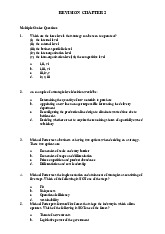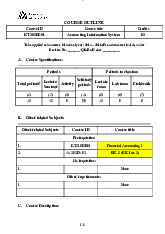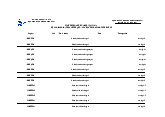






Preview text:
lOMoAR cPSD| 47205411 REVISION CHAPTER 1
Chapter 1 Systems fundamentals
Multiple Choice Questions 1.
The role of the accountant has changed in recent times because: a.
Professional bodies have sought to redefine and reposition the accounting function. b.
Computer systems have emerged to handle the classification and
recording tasks traditionally associated with the accounting function. c.
The accounting cycle is too complex and involved to be performed solely by the accountant. d.
Knowledge workers have increasingly replaced accountants in the
performance of recording and classification tasks. 2.
As computer systems have been developed to perform the recording and classification
tasks associated with business activities, the nature of accounting and the work of the
accountant have also been pushed in a new direction. Increasingly, the role of the accountant is seen to be to: a.
Use computer programs rather than manual journals. b.
Ensure that businesses invest in new software. c.
Add value and provide and interpret information for an organisation. d.
Outsource accounting work to bookkeepers. 3.
The ICAA requires that its members should bring their analytic expertise to several
fields. Which one of the following field is NOT specified by the ICAA? a.
Strategic planning and change management b.
Market analysis and compliance c.
The use of information technology d.
Human resource management 4. What does ERP stand for? a.
Enterprise Resource Planning b. Enterprise Resource Package c. Electronic Resource Planning d. Electronic Resource Package lOMoAR cPSD| 47205411
Testbank to accompany: Accounting information systems 4e 5.
Which of the following statements is NOT a major reason of why accountants of the
twenty-first century must be comfortable with information systems concepts? a.
Computer systems are playing an increasing part in the management and
functioning of the organisation b.
Accountants are increasingly exposed to and working with technology and information systems c.
Accountants need to know how computers manage knowledge and its data resources. d.
Accountants need to lead and oversee the design of an accounting information system. 6. Information is: a. the same as data. b.
data that has been processed and converted. c. less useful than data. d.
raw facts describing an event. 7. What is information overload? a.
The situation where a computer has more information than is needed or is able
to be processed in a meaningful way when a computer program is executed. b.
The situation where an individual has more information than is needed or
is able to be processed in a meaningful way when working through a decision. c.
The situation where a computer has more information than is needed or is able
to be processed when data storage is taking place. d.
The situation where the amount of information exceeds the storage capacity of the brain of a human being. 8.
Which of the following statements best indicates the difference between data and information: a.
information and data are the same. b.
information is less useful than data. c.
information is always useful whereas data is only sometimes useful. d.
information is data that has been processed and converted lOMoAR cPSD| 47205411
Chapter 1: Systems fundamentals 9.
The following message box appears when entering a customer order into a sales system: This is an example of: a. Input b. Process c. Output d. Feedback 10. A system can be defined as: a.
activities that are performed on inputs b.
any device used to capture data including manual keying and scanning. c.
any process that an accountant is involved in. d.
something that takes inputs, applies a set of rules or processes to the
inputs and generates outputs. 11. Inputs can include: a.
receipts and invoices that are given to customers. b.
data as well as other resources, that are the starting point for the system. c.
any process that an accountant is involved in. d.
computer reports that are analysed by accountants. 12.
A large company that provides supplies to the defence forces has just established a
new accounting system. Which of the following is an example of a factor in the
external environment that would impact on the design of this system: a.
The specification details gained from users. b.
The directive from the finance director about the system’s operation capacity. c.
The defence force requirement regarding e-commerce. d.
The accounting standards governing large companies. lOMoAR cPSD| 47205411
Testbank to accompany: Accounting information systems 4e 13.
MICR is an input technology used: a.
on receipts and invoices that are given to customers. b. on bank cheques. c.
in the processing of ATM receipts. d.
by many organisations to expedite the processing of accounts payable invoices. 14.
Over time, the relationship between accounting and information systems has seen: a.
Accounting gain an increased role as the emphasis shifted from information systems to accounting b.
Information systems gain an increased role as the emphasis shifted from
accounting to information systems c.
Information systems and accounting share the emphasis d.
Both accounting and information systems become part of a wider organisational IT function 15.
“Charlie & Dave’s Computer Store” is considering the best way to enter data about
new customers that sign up as part of a new marketing campaign. Customers
complete their details on a form and leave them at the store for further processing.
The best method for capturing this data would be: a.
scanning through barcode technology. b. optical mark readers. c. manual keying. d.
scanning through image scanners. 16.
An accounting information system can best be defined as: a.
The application of technology to the capturing, storing, sorting and reporting of data. b.
The application of technology to the capturing, storing, sorting and reporting of information. c.
The application of technology to the capturing, verifying, storing, sorting and
reporting of information relating to an organisation’s activities. d.
The application of technology to the capturing, verifying, storing, sorting and
reporting of data relating to an organisation’s activities.. 17.
Which of the following is unlikely to be the accounting’s role to an organisation? a.
Gather data about the organisation’s activities. b.
Provide a means for business data storage and processing. lOMoAR cPSD| 47205411
Chapter 1: Systems fundamentals c.
Convert business data into useful information. d.
Exercise strategic decision-making according to accounting information. 18.
An accounting information system is unlikely to help a firm to: a.
determine whether to approve a credit sale b.
decide how much to purchase from suppliers c.
determine the provision for bad debts d. eliminate financial fraud 19.
There are a few source documents that contain accounting data. An accounting clerk
enters these data into an accounting program hosted in a computer. The computer
displays an analysis report on screen when the accounting program has finished processing the data.
In this scenario, the accounting information system consists of: a. The accounting program. b.
Source document and the accounting program. c.
Source document, the accounting program, and the computer. d.
Source document, the accounting clerk, the accounting program, and the computer. 20.
An example of an output from an accounting information system could be: a.
the screen for entering transactions. b.
the screen for selecting what report to produce. c.
the screen that lists updated and categorised account balances. d.
the screen for entering file saving locations. 21. Feedback: a.
always includes an error message. b.
is the method to indicate that a problem exists. c.
never includes an error message. d.
is the method for ensuring that the system is running as normal and that there
are no problems or exceptional circumstances. 22.
The role of the accountant has changed in recent times because: a.
professional bodies have sought to redefine and reposition the accounting function. lOMoAR cPSD| 47205411
Testbank to accompany: Accounting information systems 4e b.
Computer systems have emerged to handle the classification and recording
tasks traditionally associated with the accounting function. c.
The accounting cycle is too complex and involved to be performed solely by the accountant. d.
Knowledge workers have increasingly replaced accountants in the
performance of recording and classification tasks. 23.
Which of the following statements concerning working professionals is correct? a.
A working professional in the accounting domain will not be involved in system development. b.
A working professional in a domain extended beyond accounting is more
likely to be involved in system development than their counterparts in the accounting domain. c.
A working professional in a domain extended beyond accounting is less likely
to be involved in system development than their counterparts in the accounting domain. d.
System development will be part of the career of a working professional in the accounting domain. 24. Data Mining is: a.
a technology that is used by large multinational resource companies such as BHP, Rio Tinto and Xstrata b.
declining in popularity with companies due to the emergence of newer technologies. c.
a technology that analyses small pools of internally generated data and
identifies possible cost savings. d.
a technology that analyses large pools of data and identifies patterns in them
that can then be used by organisations for decision making. 25.
Which of the following factors will impact on the way an auditor goes about the audit
of an information system? (i) Legislative requirements (ii) Professional requirements;
(iii) Prescription of the various auditing standards; (iv) Unique characteristics of the individual client. a. i, iii b. i, ii, iii c. i, ii, iv d. i, ii, iii, iv Short Answer Questions lOMoAR cPSD| 47205411
Chapter 1: Systems fundamentals
1. Traditionally, the role of an accountant is to capture and record financial information. Has
this role changed? Why or why not?
2. What are the differences between data and information?
3. Information overload can be harmful to both individuals and the relevant organisation, why?
4. Describe the relationship between input, process, and output.



